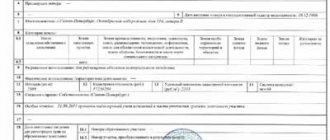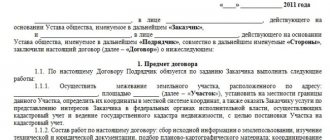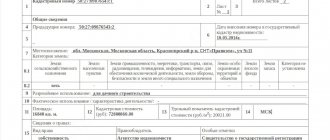Division of land according to Art. 11.2, clause 1, art. 11.4 of the Land Code of the Russian Federation is a method of converting a plot into two or more real estate objects. Upon division, the original plot ceases to exist, and the resulting new land holdings must strictly comply with the requirements of the law. In accordance with paragraphs. 1-2 tbsp. 11.9 of the Land Code of the Russian Federation, land plots that do not fall under the influence of the municipality fall under the jurisdiction of national legislative acts. According to Part 4 of Art. 41 of the Town Planning Code of the Russian Federation, when dividing the original land plot, a prerequisite is the availability of approaches to the newly formed land holdings.
The concept of land division
Within the framework of land legislation, part of the plot is not the object of legal relations, because As a result of dividing the plot into two parts, new land plots of smaller sizes are obtained. Each owner has the opportunity to divide his property in order to be able to alienate a certain part of it.
The division of a plot means the method of forming plots, which is enshrined at the legislative level in Article 11 of the Land Code of the Russian Federation.
As a result of such a procedure, several sections are formed, and the original single section from which they were formed, accordingly, ceases to exist. This rule is mandatory, with the exception of certain cases established by law.
As a result of the division, the owner of the original single plot acquires ownership rights to all received objects.
Impossibility of partition
The rules for dividing a land plot are defined in the Land Code. It also lists cases in which it is impossible to perform the division procedure:
- the size of the plot is less than the accepted standards;
- the required documentation is missing;
- after division the purpose of the territory will change;
- the formed parts are deprived of access to the road, exit, passage;
- new boundaries are imposed on the area of forest park zones and forest districts;
- after division, broken boundaries appear, interspersed, wedged in, striped;
- sanctions or temporary restrictions have been imposed on the facility.
Time restrictions imply the presence of a mortgage; arrest imposed on the basis of a court decision; easement, etc.
The purpose of the division of the site. The procedure for dividing a plot. Minimum lot size for a partition
The division of a single plot is carried out solely at the personal request of the real owner. The most common reason for starting this procedure is the desire to sell part of your real estate. During division, the owner has the opportunity to sell part of the land, leaving the rest in his own property.
At the legislative level, the minimum size of plots is divided depending on the category of land. In particular, the minimum acceptable size is:
- plot for farming - area 2 hectares;
- plot for personal gardening - area 0.06 hectares;
- a plot intended only for gardening - size 0.04 hectares;
- plot for personal dacha construction - size 0.06 hectares.
Surveying process
In order to begin carrying out boundary work, the owner must prepare papers for this. Usually, all that is required is a citizen’s passport and a document that would confirm land rights.
It will be necessary to find specialists who will take measurements and survey the plots. In such situations, you should contact the BTI (technical inventory bureau), where for a certain fee, since land surveying is a service provided by government agencies, the prescribed measures will be carried out.
The land surveying procedure involves going through several stages, which include the participation of both the land owner and specialists:
Preparatory stage. It is here that the owner collects documents, negotiates with neighbors if necessary, and selects specialists for the work.
Inspection and study of the boundaries of the site, adjacent territories and their features. Designation of existing signs to determine their future fate.
Developing a plan. It will reflect the step-by-step actions of specialists, which will be aimed at obtaining all the important information about the site.
Notifying neighbors and all those who are interested in carrying out this work. Moreover, no work can begin without the participation of the owner himself or without his permission.
This is an important rule, since not only the owner, but also another person can order land surveying. Geodetic survey of the territory and the formation of the obtained data, their processing and full analysis.
Preparation of final documentation. You need to make sure that all papers are signed by authorized persons.
Expert opinion
Korolev Denis Igorevich
Lawyer with 10 years of experience. Specialization: civil law. Member of the Bar Association.
Transfer of the survey file to the cadastre service, which, within about five days, based on them, will draw up and issue to the applicant a cadastral passport, which is an integral part of the technical documentation of any plot.
To carry out all of the above actions, it will be necessary to attract diverse specialists. These are cadastral engineers who carry out measurements and surveys of the territory, and geodetic workers who carry out surveys, and employees of the cadastral chamber.
In order to decide which specialists to contact, you first need to choose an organization. These can be private independent companies that have received a license for a similar type of activity, or government agencies
It is also important to pay attention to the education and qualifications of the performers, since errors are often made during measurements and inspections, and in thirty percent of cases there is not even a visit to the territory
Thus, land surveying is a set of documents that contain the necessary data about a specific piece of land. Without it, it will be impossible to register the right to the plot, as well as to dispose of the plot in the future, including through concluding transactions.
The establishment of boundaries (boundaries) of land plots became necessary as soon as people began to lead a sedentary lifestyle. Because of this, such a profession as a land surveyor even appeared on Earth.
Today, land surveying is required mainly in new areas where boundaries have not been established, or where they are unclear and need to be restored. Specialists in the field of land surveying are called engineering surveyors or cadastral engineers.
The boundaries of land plots (LP) are fixed not only on the ground - they are included in the technical boundary plan, which is included, along with the rest of the documentation, in the survey file and sent to the state land management committee. What is land surveying, how is it formed, and where can it be obtained?
Formation of a plot by division
The formation of a single plot means a certain stage that precedes the inclusion of this property in civil circulation.
However, it is worth remembering that a site that has gone through the formation process will not immediately become a participant in the turnover, since first it needs to go through certain procedures that precede its formation. These procedures mean registering an object for cadastral registration and making it available to the owner under any right.
Based on the Land Code of the Russian Federation, rules are established on the basis of which plots are formed. In total, there are several reasons for the formation of sites, including:
- chapter;
- Union;
- redistribution;
- selection
The division of a single plot can be carried out exclusively in relation to an already existing plot of land.
Land Code
The procedure is regulated by the Land Code of the Russian Federation, the Federal Law on Real Estate Registration, and other legal acts.
- Art. 1 Federal Law No. 218 – general provisions, including clause 7 – cadastral registration.
- Art. 8 No. 218 “On state registration of real estate” – basic and additional information.
- Art. 11.4 RF Land Code – basic rules.
- Art. 11.9 of the Land Code of the Russian Federation - conditions, non-compliance with which will lead to a ban on delimiting land.
- Art. 26 Federal Law No. 218 – grounds for suspension of real estate registration.
- Other regulatory legal acts, for example, Art. 13 Federal Law No. 214 – on shared construction.
Section of the plot in kind
As a result of land management, a single plot of land is divided into two or three new objects, each of which must meet established requirements. Initially, each such piece of real estate obtained through division in kind must undergo the cadastral registration procedure, after which it will be able to fully participate in civil circulation.
The allocation of each plot obtained by division in kind is carried out simultaneously; it is enough just to provide a certain package of correctly executed documents.
Types of sections
The division procedure may be needed in different situations:
- if there is one owner for the purpose of exchange, sale, donation of land;
- between spouses during a divorce;
- between heirs, when the common part of the inheritance is divided between family members;
- between several owners who wished to receive their share for sole use.
Division with preservation of the original land plot occurs in a situation where, after completing the procedure, one or more plots should be formed as part of the main one. In another case, all possible parts are formed, and the original one ceases to exist. The type of division is chosen by the owner or interested party.
Land is part of the joint property in a marriage. In case of divorce, the division is carried out on the basis of an agreement concluded between the spouses on the division of the land plot, or through the court if it was not possible to agree.
The division of land between heirs is possible after receiving a certificate of inheritance. The heirs can enter into an agreement or resolve the issue through the court. The judge will examine the data provided by the participants. When considering a case, the court may conduct an additional examination and re-check the purpose of the allotment.
The division can be carried out through an agreement (of everyone who owns a share) or through a court. In the first case, the owners collect the necessary documentation, enter into an agreement, and register the right to own new shares of land. In the second case, a claim is filed in court. The statement of claim can be filed by the sole owner or owners with shares. The court issues a decree on the division of the land plot in kind and determines how the land will be used.
Division of the plot through the court. Statement of claim for division of land
If there is no agreement between all owners on the peaceful division of the land, you can go to court for division. In fact, this situation occurs quite often, so there is no need to fear the initiation of legal proceedings.
The exact boundaries of the division for the subsequent land use of individuals will be determined by the court on the basis of its special land management examination.
In this case, after filing a claim and a positive decision of the court, the corresponding decision will act as a statement of the consent of all owners, which will establish the exact procedure for land use of the new plots.
Taking into account the actual relations
On August 20, 2021, the Judicial Collegium for Civil Cases of the Supreme Court of the Russian Federation adopted determination N 127-KG19-12, in which it interpreted the provisions of the Land Code of the Russian Federation regarding the determination of the procedure for using a land plot (clause 1 of Article 35 of the Land Code of the Russian Federation) .
In this ruling, the Supreme Court of the Russian Federation reflected a number of conclusions that are interesting from a legal point of view, which very soon may become the basis for the formation of a new layer of law enforcement practice in disputes between shared owners whose common real estate is located on a land plot provided for perpetual use.
Fable of the case
At the center of the dispute is a conflict between two groups of shared owners of a homeownership located in the Republic of Crimea and consisting of residential buildings and outbuildings. The first group is represented by the owner of a share in home ownership in the amount of 34/100 (plaintiff), inherited from her husband. The second group includes two owners who own a share in the amount of 66/100 (defendants), which they had previously acquired from the plaintiff’s husband under a purchase and sale agreement.
The land plot on which the house is located was provided to the predecessor of the current owners in 1958 by the city executive authority for perpetual use for the construction of an individual residential building.
From the text of the judicial act it is clear that the parties to the conflict cannot register ownership of the disputed land plot due to disagreements regarding its use. That is, the owners of the home ownership continue to remain subjects of the right of perpetual use, and the subject of the claim is the requirement to determine the procedure for using the land plot.
At the same time, the parties independently, without legal registration, determined the procedure for using the buildings that are part of the home ownership (the houses were actually distributed between the plaintiff and defendants without any additional work to allocate shares).
The plaintiff also claims that by the time the defendants acquired shares in the right to home ownership, the established procedure for using the disputed land plot already existed. According to the plaintiff, the defendants agreed with him when purchasing the share by signing a purchase and sale agreement. In addition, a boundary fence has been installed on the disputed area for more than 15 years.
During the construction and technical examination carried out within the framework of the case, it was established that:
• the area of the land plot according to the public register (485 sq. m) is less than the area of the land plot actually used by the parties (545 sq. m)
• each of the houses is located on a separate part of the land plot, equipped with an isolated entrance and has an independent system of electricity, water, gas supply, heating and drainage
• the expert proposed an option for determining the procedure for using a land plot, according to which part of the plot with an area of 246 square meters. m is provided for use by the plaintiff, the other part with an area of 299 sq. m. m - to the defendants.
The courts of first and appellate instances dismissed the claim.
The main argument of the Zheleznodorozhny District Court of the city of Simferopol was that the procedure for using the land plot, proposed by the expert, taking into account the actual area of the land plot (545 sq. m.), does not correspond to the owners’ shares in the right of common shared ownership of the home, which, in the court’s opinion, violates para. 2 p. 1 art. 35 of the Land Code of the Russian Federation.
The Supreme Court of the Republic of Crimea, in its appeal ruling, recognized the above-mentioned argument of the trial court as illegal, but left the decision unchanged as consistent with the law, indicating that determining the procedure for using a land plot is possible only after the court has determined the procedure for using the buildings located on such a plot or simultaneously with it, as well as after registration in the manner prescribed by law of the right to use the land plot, establishing its boundaries in accordance with the requirements of the legislation of the Russian Federation .
The Judicial Collegium for Civil Cases of the Supreme Court of the Russian Federation did not agree with the legal argumentation of the lower courts, canceled the judicial acts adopted by them and sent the case for re-examination to the court of first instance.
Conclusions of the Supreme Court of the Russian Federation and their practical significance.
- The current legislation does not establish the need for exact correspondence of the part of the land plot allocated for use to the size of the share in the right of common shared ownership of the building.
According to paragraph 2 of paragraph 1 of Article 35 of the Land Code of the Russian Federation, in the event of a transfer of ownership of a building or structure to several owners, the procedure for using the land plot is determined taking into account the shares in the ownership of the building, structure or the established procedure for using the land plot.
A literal reading of this provision reveals at least two aspects taken into account by the courts when determining the procedure for using the site: a) the size of the share in the ownership of the building; b) the established procedure for using the land plot. Moreover, the presence of the conjunction “or” between them implies that both mentioned criteria cannot be used simultaneously. In addition, the very wording of the norm (the phrase “taking into account”) makes it clear that the specified criteria are a kind of legislative guideline for the courts in making a fair decision, but does not at all mean that it is impossible to deviate from such a guideline if necessary. And there is precisely a need in the case under consideration. From the text of the decision of the Judicial Collegium it follows that the part of the disputed land plot, which is in actual use of the plaintiff, has significant shortcomings. Thus, access to the site is possible through a narrow passage with a total area of 42 square meters. m, one of the sides of which is a retaining wall to the slope with a height difference of about three meters, and under the path paved with concrete slabs on the street side there is a system for draining storm water from the above-located land plot. Thus, if the court allocated to the plaintiff for use a part of the disputed land plot corresponding to his share in the ownership of the house (34/100), this would lead to the fact that the part of the plot necessary for servicing the plaintiff’s buildings would be in the use of the defendants , which would not allow the plaintiff to fully exercise his rights to own and use the buildings.
To delve deeper into the logic of the Supreme Court of the Russian Federation, one should turn to the practice of resolving a similar issue using the example of the general provisions of the Civil Code of the Russian Federation on determining the procedure for owning and using property that is in common shared ownership.
There are often cases when the share of one of the co-owners in the right to a common building is so small that it is not possible to divide such a building in kind or to separate a share from it. However, this does not mean at all that the owner will be forcibly deprived of his share with subsequent payment of compensation to him (clause 3 of Article 252 of the Civil Code of the Russian Federation). In the case where the co-owners do not set as their goal the division of common real estate, but cannot come to an agreement on the issue of ownership and use of it, each of them has the right to apply to the court with a claim to determine the order of ownership of the common property (Clause 1 of Art. 247 of the Civil Code of the Russian Federation). From the explanations of the Plenum of the Supreme Court of the Russian Federation and the Supreme Arbitration Court of the Russian Federation, contained in paragraph 37 of Resolution No. 6/8 of 07/01/1996 “On some issues related to the application of part one of the Civil Code of the Russian Federation”, it follows that the owner also has such a right , the share of which cannot be identified, including due to its insignificant size. In resolving such a requirement, the court takes into account the actual procedure for using the property, which may not exactly correspond to the shares in the right of common ownership, the need of each of the co-owners for this property and the real possibility of joint use.
It seems obvious that this position can and should be applied by analogy to the legal relations of persons arising from the joint use of a land plot transferred to such persons for perpetual use.
In the ruling under consideration, the Supreme Court of the Russian Federation indicated that the most important issues to be investigated in such cases are the question of the need of each of the users of the land plot to use one or another part of it and the established procedure for using the plot. And also that the disproportion of the part of the plot transferred to the owner to his share in the right to home ownership can be eliminated by providing monetary compensation.
Since over 15 years the parties have developed a certain procedure for using the disputed land plot (and there is even a demarcation fence), the court of first instance, when re-examining the case, will probably be forced to take this circumstance into account, as well as the shortcomings of that part of the land plot used by the plaintiff .
Thus, the Supreme Court, in its ruling, confirmed that the courts have the opportunity to exercise a certain degree of flexibility when resolving disputes regarding the determination of the procedure for using land plots, which hypothetically will facilitate the courts making fair decisions on this category of disputes, taking into account all the features of a particular plot and the existing relations of shared owners buildings.
- The shared owners of a structure do not have the obligation to determine in court the order of ownership and use of it before filing a claim in court to determine the order of use of the land plot on which such a structure is located.
In fact, the circumstances are such that the plaintiff and defendants determined the procedure for using the home ownership independently; there is no dispute between the parties on this issue. At the same time, the appellate court in its ruling came to the conclusion that it was necessary to resolve this issue in court before making a decision on the present case or simultaneously with it.
The Judicial Collegium of the Supreme Court of the Russian Federation stated the absence of such a requirement in the law. The position on the illegality of imposing on individuals the obligation to seek judicial protection of their rights and legitimate interests in a situation where there is no dispute about the right seems logical and consistent with the principle of the inadmissibility of arbitrary interference by anyone in private affairs (Clause 1 of Article 1 of the Civil Code of the Russian Federation).
They do not contain current legal acts and provisions obliging shared owners of buildings to re-register the right to use a land plot (bring documents into compliance with the legislation of the Russian Federation), as well as to establish boundaries (land surveying) of such a land plot.
A significant issue, practically not touched upon by the determination of the Judicial Collegium of the Supreme Court of the Russian Federation dated August 20, 2019 N 127-KG19-12, remains the ratio of the area actually used by the owners and the area of the land plot according to the data of title and title documents. Apparently, the Zheleznodorozhny District Court of Simferopol will have to give a legal assessment of this circumstance and determine the degree of influence on the outcome of the conflict during a new consideration of the case.
Rules established for the division of land plots
When dividing plots, it is necessary to comply with several rules and a certain procedure:
- each new site must have its own entrance or approach;
- the original plot from which new real estate objects were formed ceases to exist after the end of this procedure;
- after dividing his plot, the owner has ownership rights to all real estate objects formed through this procedure;
- all participants in common ownership also retain their right to each plot formed as a result of formation, unless otherwise established at the level of an agreement concluded between the parties.
Grounds and reasons for the partition
The division of existing land plots can be carried out on several grounds:
- In case of acquisition of a plot by several co-owners for the purpose of exploitation of the plot, if it was decided to exploit it independently by each owner;
- In the event that a land plot is inherited (if it is owned by the testator or in lifelong inheritable possession) to several heirs. At the same time, the total area of the plot is greater than the minimum (if there are three heirs, then 18 acres or more, four - 24 or more, etc.);
- The division of jointly acquired property is carried out by the spouses when they make such a decision or in the event of divorce;
- The desire of the owner of one plot to form several new ones by allocating shares in his property for further disposal of shares;
- In the case of lands provided to horticultural non-profit partnerships, if the participants of such a partnership have decided to register their plots as individual property (the common allotment remains within the changed boundaries);
- If during the operation of the leased plot it becomes necessary to redistribute the land by dividing it, and such division is carried out by the owner of the plot at the request of the tenant.
Boundary plan for the division of land
At the moment, employees of the cadastral chamber do not accept a paper boundary plan when dividing a plot. Now only the electronic version is relevant, which includes:
- text part. This part is prepared by a cadastral engineer;
- graphic part. The preparation of this part is also carried out by the engineer;
- application. This part is provided by the customer.
The main thing in the boundary plan is a drawing on which the boundaries of future sites are clearly marked.
Author of the article
What it is
When one plot of land is divided into several shares, independent plots are formed. In this case, the original site ceases to exist.
. Only an allotment with specified boundaries can be divided; if they are not defined, then such an object can be divided into several parts if the boundaries of the new allotments coincide exactly with the old ones. But in this case, the boundary plan must include acts of coordination of the boundaries of the newly formed parts with the boundaries of the original one.
It is allowed to divide the original land plot within the changed boundaries if the lands are owned by the state or municipality. They can be allocated to citizens for use through gardening, dacha and gardening associations.
After the division is carried out, new plots are assigned cadastral numbers, and the original plot retains its number within the changed boundaries. This rule applies to cases where, after transformation, at least two plots remain in the land use composition.
Just as in cases with a regular division, acts of coordination of the original boundaries of the site and the newly formed ones are necessary only when dividing a site that has unspecified boundaries. But if the formation of a site is carried out without affecting the external boundaries of the original site, then an approval act is not required.
Documents required for accounting
Typically, the applicant is required to submit the following documents for registration:
- an original or copy of a paper that could confirm the fact that your site belongs to a certain category of land;
- document on the applicant's credentials;
- original land use permit;
- copies of the land survey project and documents confirming the approval of the land survey project;
- duly certified copies of the decision and (or) agreement on the provision of a land plot for construction by an executive body of state power or a local government body;
- map-plan of the territory (in case of complex cadastral works).
The provided documents must be certified by a notary, and acts of government authorities must be certified by the signature and seal of an authorized person. If the original document is provided, a photocopy is made and the original is returned.
How to divide?
The procedure for dividing a land plot into several parts is as follows.
A statement is written about the need to divide the existing plot into several parts. This statement is written to the administration and authorized bodies.
Within thirty days, it is reviewed for the possibility of dividing the site in compliance with sanitary standards.
A sample application for division of land is available here.
Based on the decision made on the possibility of such a division, interested parties turn to the cadastral engineer with another application - to carry out work on the division. These works are paid, therefore, if the engineer agrees, a service agreement is concluded.
The cadastral engineer is provided with all survey and cadastral documents available for the site that characterize the site. If the plot has several owners, and only one wants to carry out the division or allocate his share in kind, it is necessary to provide notarized consent of the remaining owners to carry out the division. Otherwise, the issue will be resolved in court.
agreements can be found by following the link.
Based on the documents provided, the cadastral engineer carries out work on site (on the site) to create new boundaries and allocate the site into an independent plot.
Based on the results of the activities carried out, the site is registered as an independent plot with the registration of all title documents.
If the allocation of a share of a plot by dividing it is carried out in kind, then based on the results of such a division, the owner of the newly formed plot can immediately begin constructing a partition or other boundary line. At the same time, the old plot that has been divided ceases to exist from a legal point of view.
If the site must be preserved, the cadastral engineer must be warned about this separately. In this case, the entire set of measures will meet the requirements for preserving the site within the changed boundaries
. In fact, proof of the preservation of the site within the changed boundaries will be the corresponding act of the cadastral engineer.
What areas can be divided?
The division of plots can occur based on the wishes of the co-owners of the original plot or in accordance with a resolution of the authorized body for the management of state and municipal property.
At the same time, the category of the site that will be divided will not matter. That is, both lands that are classified as lands of settlements and those lands that are recognized as farmland can be divided.
The latter lands can only be divided while preserving the original plot within the changed boundaries.
When resolving the issue of the possibility of dividing a particular plot, its qualitative characteristics will play a key role, namely:
- The area of the plot, which should not be less than the sanitary standards established by law (the size of the minimum plot should range from six to seven acres depending on the region);
- The presence on the divided plot of natural or man-made objects that may complicate the operation of the newly formed plot (ravines, transformer booths to provide electricity to the residents of a particular house or street, which were installed by decision of the municipality), etc.
At the same time, the decision to divide the plot is made not only by the cadastral engineer after studying the submitted documents and establishing the fact that the existing plot complies with sanitary standards.
Such a section must be agreed upon with the local administration represented by its head or relevant official.
The need for such approval is explained by the fact that the registration of the completed division will be carried out with the introduction of appropriate changes to existing cadastral and other documents, including at the level of the local administration.










